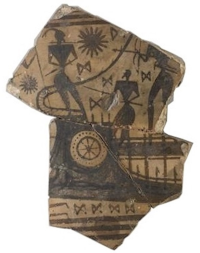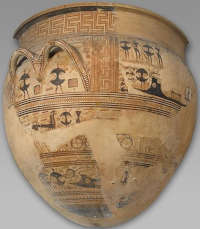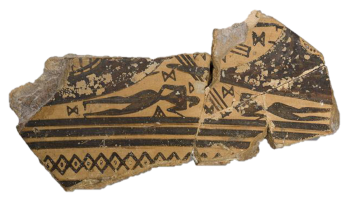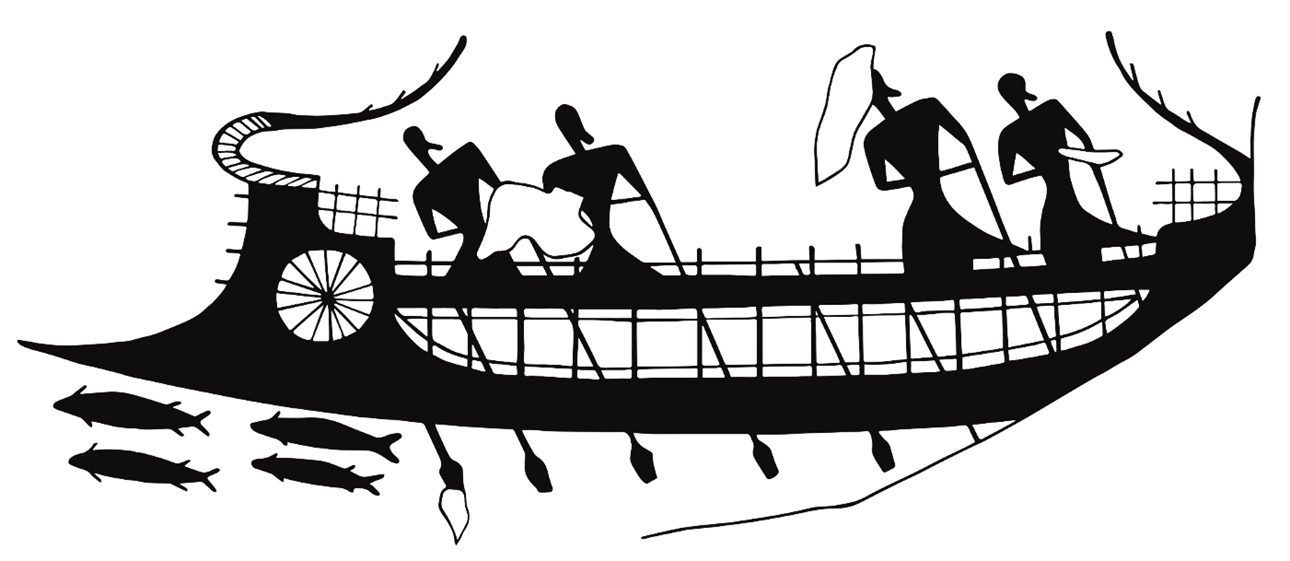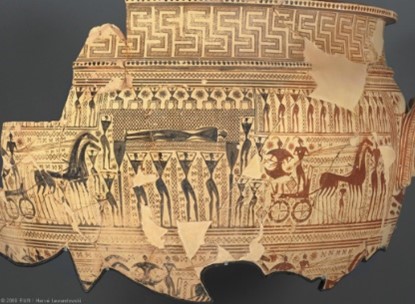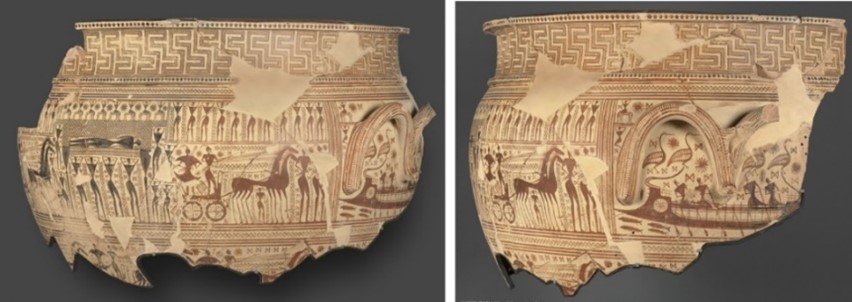Ships depicted in the Dipylon style follow strict conventional rules with little deviation from the established norm, and so it is worth deconstructing this blueprint by examining its horizontal and vertical lines. There are five horizontal lines which can be designated as A, B, C, D, and E. The lowest and thickest line (A) represents the hull. The thin line directly above it (B) is a separate rail on which the tholepins are fixed instead of directly on the gunwale. Basch argues that this allowed for a very low and therefore light hull, all the while keeping the oars on a high level. The effect was to lighten the vessel yet lenghten the oars, thus improving propulsion (Basch 1987: 164). The next three lines cluster tightly together, and consist of a central thick band (D) which represents a longitudinal deck, flanked by two thin ones (C,E) which Casson interprets as wales. The verticals are the stanchions that support the deck and form the "rooms" for the lower level rowers. The bow is a solid square block, with a concave post integrating the bow projection and ending in an S-shaped incurving horn. The occulus has a screen consisting of a spoked star. The fore- and aftercastle are integrated, with an open balustrade with lattice railing. The forecastle is double stepped. This particular depiction has four short protrusions from the stem which represent extensions of timbers from the stempost. The eye is filled with a sixteen-spoked star. There are four rowers pulling at their oars sitting on the raised deck, supported by the usual stanchions which delineate fourteen "rooms" or thwarts. There are eight oars and no tholepins. The ship is short for its height, obviously distorted in order to fill the restricted and irregular handle-panel. The lack of rowers amidships is due to a similar compromise due to the intrusiveness of the center part of the double handle. Their presence is suggested by two extra oars below.
Double-levelled galley
A130
Late Geometric I, c. 750 B.C.
Athens, Dipylon cemetery
Width (fragment): 58 cm
Attic, Dipylon Master. Pedestalled krater.
Louvre A 517
Basch 1987: 171, no. 353; Casson 1971: fig. 49-52, 72; Kirk 1949: 104-106, pl. 38.2; Morrison-Williams 1968: 22, geom. 9, pl. 3a-b; Williams 1958: 121
Coldstream attributes this krater to the Dipylon Master himself (Coldstream 2003: 88). Main central zone between the handles shows a prothesis scene, with deceased laid on a bier, surrounded by family and friends, professional female mourners, and warriors. Earliest known depiction of a gesture where two individuals next to the bier seem to be raising a chequered "blanket" or shroud with their hands extended, allowing the deceased man to be seen. Decorative scheme complemented by an escort of warriors in chariots. Warship with four rowers fills the space under a double handle, complemented by four birds above (a pair at the bow and stern) and fish below. Remaining space filled with talismanic flowers and butterflies. Peaceful ship scene is rare in this group. Wedde uses the depiction of the chariots and bier in this group to question the standard "bird's eye perspective" and to push instead for a strict profile approach to the depiction of physical objects (Wedde 1996).
This ship is not without its problems, as there was a lot of accommodation done to suit the space it was meant to fill. The most obvious artistic compromise is the number of rowers depicted, which does not match the number of oars, as well as the number of "rooms" which was shortened for lack of space. The deck is at a slightly lower level than the fore- and after platforms. The rowers are depicting at the same level as the raised deck. Above the "rooms" are the standard three parallel horizontal lines - the thick black band outlined by two thin lines which represent a thick plank, with wales below and above. These provided added lateral strength and screening for the rowers which would usually sit below deck level. A strict profile reading identifies this as a two-levelled ship which could be rowed from both levels, or from one or the other.
Basch, L. 1987. Le musée imaginaire de la marine antique. Athens: Institut Hellénique pour la preservation de la tradition nautique.
Casson, L. 1971. Ships and Seamanship in the Ancient World. Princeton: Princeton University Press.
Kirk, G.S. 1949. “Ships on Geometric Vases.” BSA 44: 93-153, pls. 38-40.
Morrison, J.S. and R.T. Williams. 1968. Greek Oared Ships: 900-322 B.C. Cambridge: Cambridge University Press.
Williams, R. T. 1958. “Early Greek Ships of two levels,” JHS 78: 121-130.


